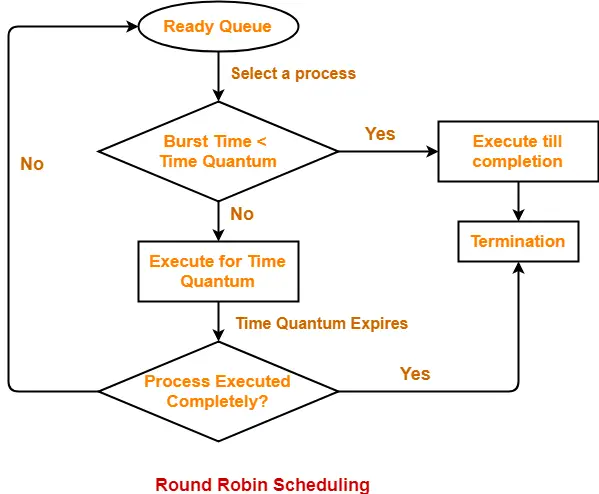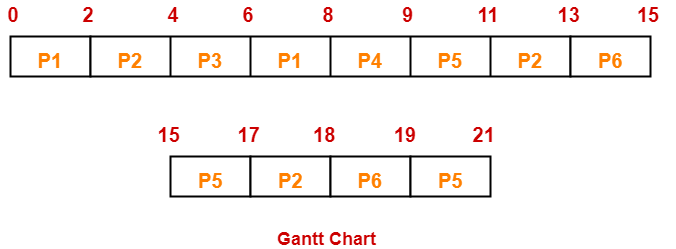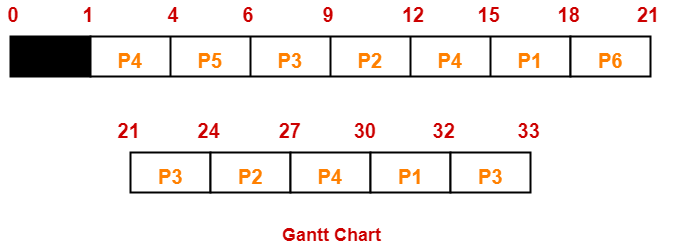Round Robin Scheduling-
In Round Robin Scheduling,
- CPU is assigned to the process on the basis of FCFS for a fixed amount of time.
- This fixed amount of time is called as time quantum or time slice.
- After the time quantum expires, the running process is preempted and sent to the ready queue.
- Then, the processor is assigned to the next arrived process.
- It is always preemptive in nature.
| Round Robin Scheduling is FCFS Scheduling with preemptive mode. |

Advantages-
- It gives the best performance in terms of average response time.
- It is best suited for time sharing system, client server architecture and interactive system.
Disadvantages-
- It leads to starvation for processes with larger burst time as they have to repeat the cycle many times.
- Its performance heavily depends on time quantum.
- Priorities can not be set for the processes.
Important Notes-
Note-01:
With decreasing value of time quantum,
- Number of context switch increases
- Response time decreases
- Chances of starvation decreases
Thus, smaller value of time quantum is better in terms of response time.
Note-02:
With increasing value of time quantum,
- Number of context switch decreases
- Response time increases
- Chances of starvation increases
Thus, higher value of time quantum is better in terms of number of context switch.
Note-03:
- With increasing value of time quantum, Round Robin Scheduling tends to become FCFS Scheduling.
- When time quantum tends to infinity, Round Robin Scheduling becomes FCFS Scheduling.
Also read- FCFS Scheduling
Note-04:
- The performance of Round Robin scheduling heavily depends on the value of time quantum.
- The value of time quantum should be such that it is neither too big nor too small.
Also read- Round Robin Program in C
PRACTICE PROBLEMS BASED ON ROUND ROBIN SCHEDULING-
Problem-01:
Consider the set of 5 processes whose arrival time and burst time are given below-
| Process Id | Arrival time | Burst time |
| P1 | 0 | 5 |
| P2 | 1 | 3 |
| P3 | 2 | 1 |
| P4 | 3 | 2 |
| P5 | 4 | 3 |
If the CPU scheduling policy is Round Robin with time quantum = 2 unit, calculate the average waiting time and average turn around time.
Solution-
Gantt Chart-
Ready Queue-
P5, P1, P2, P5, P4, P1, P3, P2, P1

Now, we know-
- Turn Around time = Exit time – Arrival time
- Waiting time = Turn Around time – Burst time
Also read- Various Times of Process
| Process Id | Exit time | Turn Around time | Waiting time |
| P1 | 13 | 13 – 0 = 13 | 13 – 5 = 8 |
| P2 | 12 | 12 – 1 = 11 | 11 – 3 = 8 |
| P3 | 5 | 5 – 2 = 3 | 3 – 1 = 2 |
| P4 | 9 | 9 – 3 = 6 | 6 – 2 = 4 |
| P5 | 14 | 14 – 4 = 10 | 10 – 3 = 7 |
Now,
- Average Turn Around time = (13 + 11 + 3 + 6 + 10) / 5 = 43 / 5 = 8.6 unit
- Average waiting time = (8 + 8 + 2 + 4 + 7) / 5 = 29 / 5 = 5.8 unit
Problem-02:
Consider the set of 6 processes whose arrival time and burst time are given below-
| Process Id | Arrival time | Burst time |
| P1 | 0 | 4 |
| P2 | 1 | 5 |
| P3 | 2 | 2 |
| P4 | 3 | 1 |
| P5 | 4 | 6 |
| P6 | 6 | 3 |
If the CPU scheduling policy is Round Robin with time quantum = 2, calculate the average waiting time and average turn around time.
Solution-
Gantt chart-
Ready Queue-
P5, P6, P2, P5, P6, P2, P5, P4, P1, P3, P2, P1

Now, we know-
- Turn Around time = Exit time – Arrival time
- Waiting time = Turn Around time – Burst time
| Process Id | Exit time | Turn Around time | Waiting time |
| P1 | 8 | 8 – 0 = 8 | 8 – 4 = 4 |
| P2 | 18 | 18 – 1 = 17 | 17 – 5 = 12 |
| P3 | 6 | 6 – 2 = 4 | 4 – 2 = 2 |
| P4 | 9 | 9 – 3 = 6 | 6 – 1 = 5 |
| P5 | 21 | 21 – 4 = 17 | 17 – 6 = 11 |
| P6 | 19 | 19 – 6 = 13 | 13 – 3 = 10 |
Now,
- Average Turn Around time = (8 + 17 + 4 + 6 + 17 + 13) / 6 = 65 / 6 = 10.84 unit
- Average waiting time = (4 + 12 + 2 + 5 + 11 + 10) / 6 = 44 / 6 = 7.33 unit
Problem-03:
Consider the set of 6 processes whose arrival time and burst time are given below-
| Process Id | Arrival time | Burst time |
| P1 | 5 | 5 |
| P2 | 4 | 6 |
| P3 | 3 | 7 |
| P4 | 1 | 9 |
| P5 | 2 | 2 |
| P6 | 6 | 3 |
If the CPU scheduling policy is Round Robin with time quantum = 3, calculate the average waiting time and average turn around time.
Solution-
Gantt chart-
Ready Queue-
P3, P1, P4, P2, P3, P6, P1, P4, P2, P3, P5, P4

Now, we know-
- Turn Around time = Exit time – Arrival time
- Waiting time = Turn Around time – Burst time
| Process Id | Exit time | Turn Around time | Waiting time |
| P1 | 32 | 32 – 5 = 27 | 27 – 5 = 22 |
| P2 | 27 | 27 – 4 = 23 | 23 – 6 = 17 |
| P3 | 33 | 33 – 3 = 30 | 30 – 7 = 23 |
| P4 | 30 | 30 – 1 = 29 | 29 – 9 = 20 |
| P5 | 6 | 6 – 2 = 4 | 4 – 2 = 2 |
| P6 | 21 | 21 – 6 = 15 | 15 – 3 = 12 |
Now,
- Average Turn Around time = (27 + 23 + 30 + 29 + 4 + 15) / 6 = 128 / 6 = 21.33 unit
- Average waiting time = (22 + 17 + 23 + 20 + 2 + 12) / 6 = 96 / 6 = 16 unit
Problem-04:
Four jobs to be executed on a single processor system arrive at time 0 in the order A, B, C, D. Their burst CPU time requirements are 4, 1, 8, 1 time units respectively. The completion time of A under round robin scheduling with time slice of one time unit is-
- 10
- 4
- 8
- 9
Solution-
| Process Id | Arrival time | Burst time |
| A | 0 | 4 |
| B | 0 | 1 |
| C | 0 | 8 |
| D | 0 | 1 |
Gantt chart-
Ready Queue-
C, A, C, A, C, A, D, C, B, A

Clearly, completion time of process A = 9 unit.
Thus, Option (D) is correct.
To gain better understanding about Round Robin Scheduling,
Next Article- Priority Scheduling
Get more notes and other study material of Operating System.
Watch video lectures by visiting our YouTube channel LearnVidFun.

